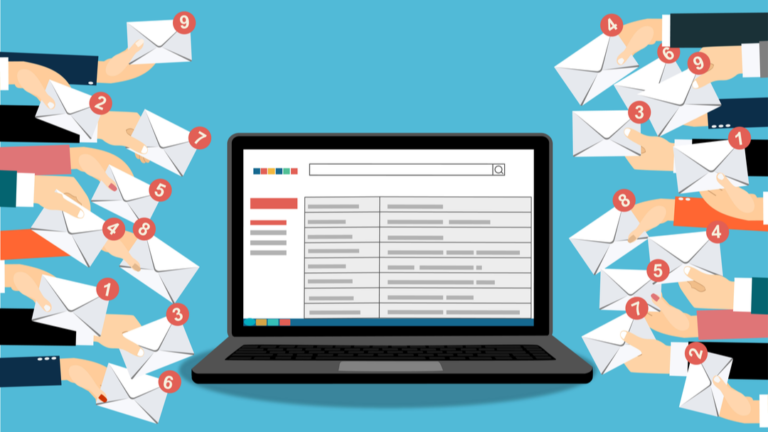Are you noticing a decline in your email engagement? If so, your emails might not be reaching your subscribers’ inboxes, and you could be blacklisted. Conducting a quick email blacklist check can help you determine if that’s the case. In this guide, we’ll take a closer look at email blacklists, how your IP or domain can end up on one, how that can impact your email sending and inbox reach, how to perform a domain and IP blacklist check, and how to prevent email blacklisting.
Email is a critical tool for businesses of all sizes, offering a reliable way to communicate with customers and a high ROI of $42 for every dollar spent. However, email marketing only works if your emails make it to your subscribers’ inboxes. Unfortunately, this is not always an easy feat. Let’s explore the concept of email blacklisting and highlight its key aspects.
What is an email blacklist?
An email blacklist, also known as a blocklist, is a list of IP addresses or domains that have been identified as sources of spam or other malicious activities. Email servers and internet service providers (ISPs) use these lists to filter incoming emails, preventing emails from these blacklisted IP addresses or domains from reaching recipients’ inboxes.
When an email address or domain is on a blacklist, it can negatively impact email deliverability rates, resulting in lower engagement rates and lost business opportunities. Blacklists are maintained by various organizations, such as Spamhaus, SURBL, and Barracuda Networks, and are frequently updated to include newly identified sources of spam and other malicious activities.
What could be the reason for email blacklisting?
There could be various reasons why your email is blacklisted. Some common reasons include:
1. Spam complaints: If subscribers flag your emails as spam or junk, it could lead to your domain or IP address getting blacklisted.
2. Poor email hygiene: Sending emails to inactive or invalid email addresses, or using purchased or rented email lists, can negatively impact your email reputation and lead to blacklisting.
3. Malware infections: Malicious software on your computer or server that sends spam or phishing emails without your knowledge can lead to your domain or IP address getting blacklisted.
4. Sending too many emails at once: Sending a large volume of emails in a short period can trigger spam filters and cause your domain or IP address to be blacklisted.
5. Suspicious email content: Using trigger words or phrases that are commonly associated with spam or phishing emails can lead to blacklisting.
6. Email authentication: If you are not set up correctly or are missing such as SPF, DKIM, or DMARC, your emails may fail the authentication checks and end up in the spam or junk folders or even get blocked.
7. Last activity: If your IP address or domain has been associated with previous spamming activity can lead to your email being blacklisted.
8. Technical issues: Your email infrastructure has technical issues that are causing email delivery problems.
It’s important to investigate and address the root cause of the blacklisting to prevent it from happening again in the future. Regularly monitoring your email deliverability and taking appropriate measures can help reduce the risk of being blacklisted.
When to check email blacklisting?
It’s important to run an email blacklist check regularly, especially if you notice a sudden drop in email engagement or if recipients report that they are not receiving your emails. It’s also a good idea to check for blacklisting after making changes to your email-sending practices, such as sending emails from a new IP address or using a new email service provider.
A decrease in click rates, bounced or rejected emails, blocked emails, and a sudden drop in delivery rates are indicators that may prompt an email sender to conduct an email blacklist check.
How can you check if your IP or domain is blacklisted?
There are several free online email blacklisting tools that you can use to check if your email address or domain is blacklisted. These tools scan multiple blacklists and provide a report on whether your email is listed. Some popular email blacklist check tools include GlockApps, MailerCheck, Folderly, MXToolbox, InboxAlly, Spamhaus, and BlacklistAlert.
To perform an email blacklist check, follow these steps:
Step 1: Visit the website of an email blacklist check tool.
Step 2: Enter your domain name or IP address in the search box.
Step 3: Click on the “Check” button.
Step 4: The tool will scan multiple blacklists and provide a report on whether your email address or domain is listed.
If your email address or domain is listed on a blacklist, you should take immediate action to address the issue. Contact your email service provider or IT team to identify and fix the root cause of the problem. Additionally, you should request removal from the blacklist by following the instructions provided by the blacklist provider.
These are the steps to follow if your email is blacklisted in Gmail.
Types of email blacklists
The overarching objective of email blacklists is to ensure email safety by blocking spam from reaching recipients’ inboxes. While there are various types of blacklists, familiarizing yourself with them can increase your chances of being removed from them.
1. Public blacklists
These are open to anyone to view and are maintained by independent anti-spam organizations.
2. Private blacklists
These are maintained by specific companies or organizations and are not open to the public.
3. Internal blacklists
These are used by mailbox providers to manage spam filtering for their own users.
4. IP-based blacklists
These blacklists track the reputation of IP addresses that send email and determine whether they are associated with spam.
5. Domain-based blacklists
These blacklists track the reputation of email domains and determine whether they are associated with spam.
6. Composite blacklists
These blacklists use a combination of both IP and domain reputation to determine whether emails from a sender are spam.
What are some of the most prominent email blacklists?
There are numerous email blacklists, both public and private, but some of the most prominent ones include:
- Spamhaus
- Barracuda Reputation Block List (BRBL)
- SpamCop
- Proofpoint
- SURBL
- Invaluement
- Cisco Talos Intelligence Group’s SenderBase
- Norton Safe Web
- ESET
- TrendMicro and more.
It’s important to note that being listed on one or more of these blacklists can have a significant impact on your email deliverability. Therefore, it’s essential to regularly check your domain and IP addresses against these blacklists to ensure that your emails are reaching your subscribers’ inboxes.
What to do if your IP or domain is blacklisted?
If you find that your IP or domain has been blacklisted, the first step is to identify the reason for the blacklisting by using GlockApps. After identifying the issue, it is crucial to take appropriate actions to resolve it.
Here are some general steps to follow:
Step 1: Check your email logs to determine if there is any suspicious activity or if your emails contain any spam-like content.
Step 2: Address any issues that may have caused the blacklisting, such as cleaning your email list, improving your email authentication, or fixing technical issues with your email infrastructure.
Step 3: Contact the blacklist provider and request removal from their list. Follow their procedures for delisting, which often involves submitting a request or filling out a form. Mentioned a clean step for Gmail.
Step 4: Monitor your email deliverability closely after delisting to ensure that your emails are reaching their intended recipients.
Remember that being blacklisted can have a significant impact on your email deliverability, so it’s crucial to take swift action to address the issue and prevent future blacklisting.
How email blacklisting affects your email marketing?
Email blacklisting can have a significant impact on your email marketing efforts. When your domain or IP address is blacklisted, your emails may be blocked or sent to the spam folder, reducing the chances of your audience seeing them. This can result in lower open and click-through rates, which in turn affects your overall email engagement and ROI.
Moreover, being blacklisted can harm your sender reputation, making it harder to land in the inbox in the future. This can also affect your ability to deliver transactional emails, such as password resets or order confirmations, which can lead to a poor customer experience.
It’s important to take steps to prevent blacklisting and monitor your email deliverability regularly to ensure your emails are reaching your audience’s inbox.
What steps can you take to prevent your email from being blacklisted?
There are several best practices you can follow to avoid getting on an email blacklist:
1. Use permission-based email marketing
Using permission-based email marketing means that you only send emails to recipients who have given you explicit permission to do so. This can be achieved by having a clear and transparent opt-in process, where subscribers actively choose to receive your emails. This helps to ensure that your emails are sent to engaged and interested recipients who are less likely to mark your emails as spam.
2. Keep your email list clean
Keeping your email list clean is crucial for avoiding email blacklisting. By regularly removing inactive or invalid email addresses from your list, you reduce the risk of bouncing emails and spam complaints. You can use email verification tools to ensure that the email addresses on your list are valid and active, which helps to maintain a good sending reputation.
3. Monitor your email engagement metrics
Monitoring your email engagement metrics can help you identify any issues that might lead to blacklisting. Keep an eye on your email open rates, click-through rates, and spam complaint rates. Low engagement rates and high spam complaints can signal to mailbox providers that your emails are not relevant or unwanted, leading to blacklisting. By monitoring these metrics, you can take corrective action before it becomes a problem.
4. Use a reputable email service provider
Choose a provider with a good reputation and high deliverability rates. Using a reputable email service provider is crucial in avoiding email blacklists. These providers have strict policies and procedures in place to ensure that their clients are following best practices and not engaging in spamming activities. They also have established relationships with mailbox providers and anti-spam organizations, which can help prevent their clients’ emails from being flagged as spam.
5. Follow email sending best practices
Use a consistent sending schedule, avoid using spam trigger words, and ensure your emails are properly formatted and optimized.
- Use a sender name and email address that is consistent and easily recognizable.
- Use a clear and concise subject line.
- Keep the content relevant and valuable to the recipient.
- Avoid using excessive capital letters or punctuation.
- Provide a clear and prominent unsubscribe option.
- Use a clear and simple email design that is easy to read and navigate.
- Include an unsubscribe link in your emails. Read more.
6. Use a dedicated IP address
A dedicated IP can improve your sender reputation and prevent other senders’ bad behavior from affecting your email deliverability.
7. Authenticate your emails
Use technologies like SPF, DKIM, and DMARC to verify your email sending domain and reduce the chances of your emails being spoofed or forged.
8. Use an email blacklist checker
An email blacklist checker is a tool used to scan your IP address or domain against various email blacklists. By using an email blacklist checker, you can proactively monitor your email deliverability and take action if your email is blacklisted. It is recommended to run regular email blacklist checks to avoid any negative impact on your email marketing campaigns.
9. Remove unengaged subscribers
Removing unengaged subscribers from your email list can help prevent your emails from being marked as spam and potentially getting your IP or domain blacklisted. By regularly cleaning your email list and removing inactive or uninterested subscribers, you can improve your engagement rates and maintain a good sender reputation. This can also increase the chances of your emails reaching the inbox of your active subscribers.
10. Take advantage of inbox testing tools
Inbox testing tools are software applications that allow email marketers to preview how their emails will look in various email clients and devices before sending them out to their subscribers. These tools simulate the email delivery process and provide valuable insights into the email’s rendering, spam score, and other deliverability metrics.
Inbox testing tools help marketers to ensure that their emails are optimized for all recipients, thus improving the chances of successful delivery and engagement. Some popular inbox testing tools include MailerCheck, Litmus, Email on Acid, and GlockApps.
Conclusion
Ensuring that your emails are delivered to your subscribers’ inboxes is crucial to the success of your email marketing campaigns. By being mindful of the reasons for email blacklisting, regularly checking your domain and IP address, and following the best practices we’ve outlined, you can avoid the frustration of being blacklisted and keep your email marketing on track.
With these tips, you’ll be able to maintain your sender reputation and keep your audience engaged, ultimately leading to better results for your business.







